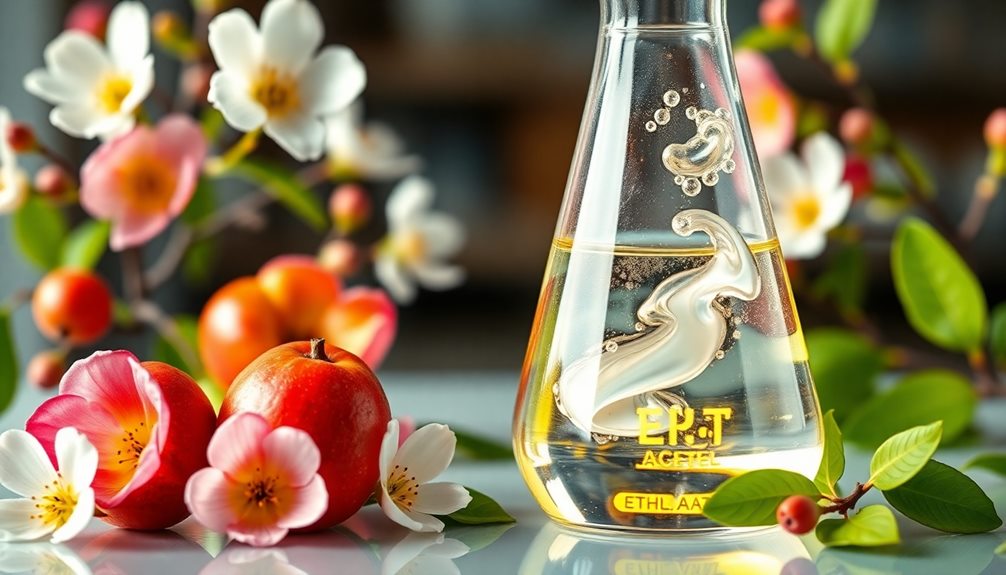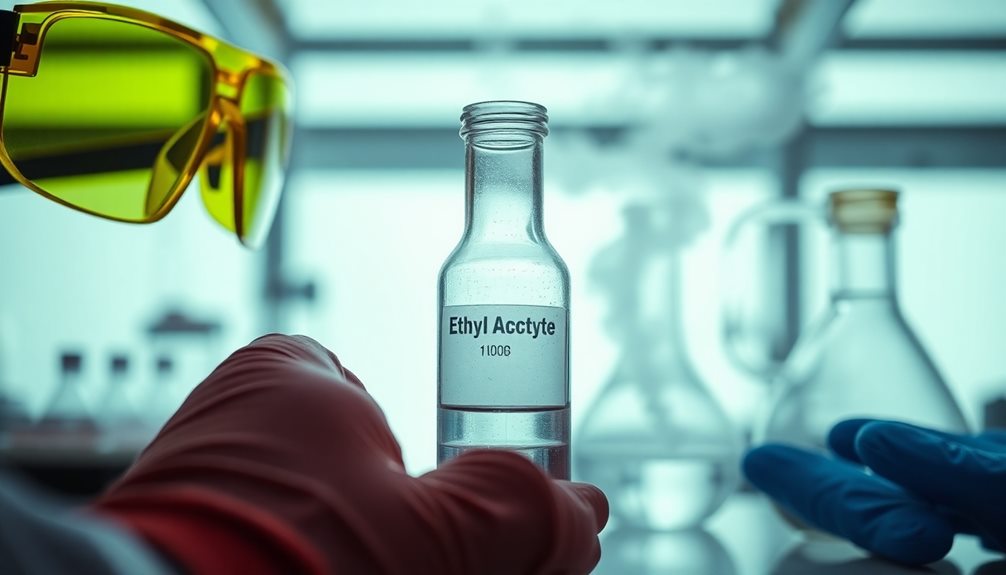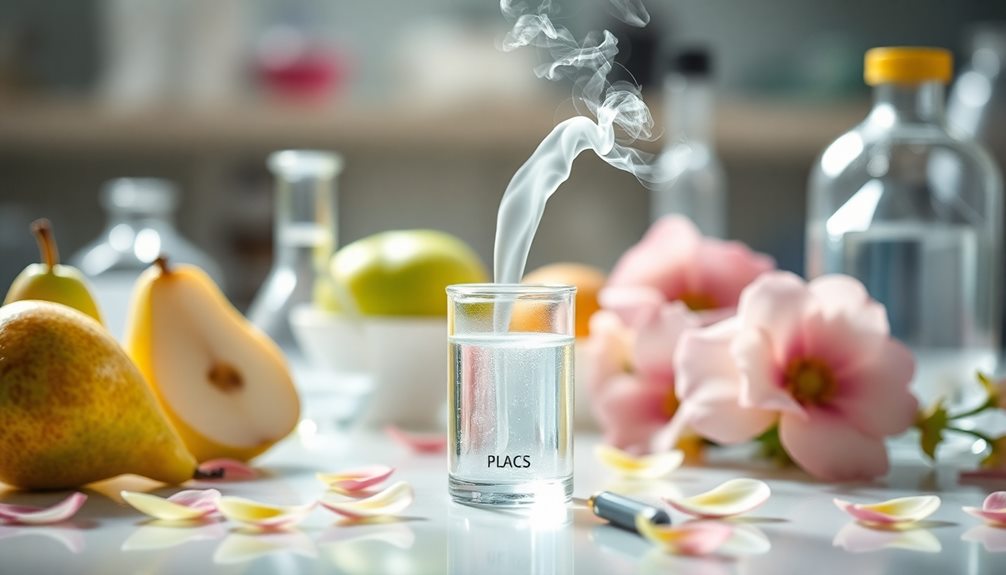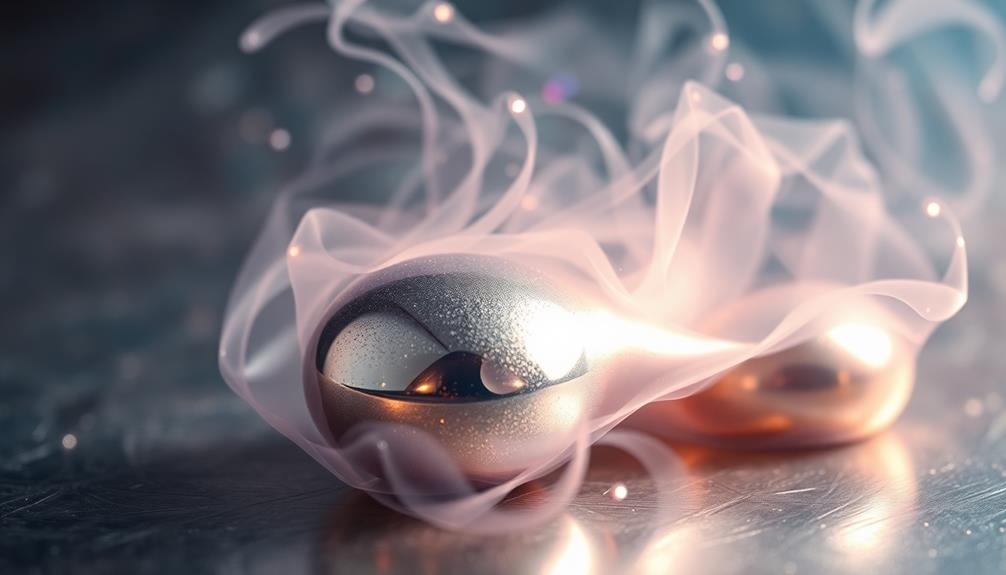Ethyl acetate smells sweet and fruity, like ripe pears and fresh apples! It often reminds you of walks through orchards or visits to candy stores. You might notice this familiar scent in products like nail polish remover, glues, and even some food flavors. While it can be pleasing and nostalgic, be cautious; high exposure can lead to headaches or dizziness. So, it's best to use it in well-ventilated spaces. Next time you catch that delightful aroma, you'll know its charming secrets, and there's even more to explore about its uses and effects!
Key Takeaways
- Ethyl acetate has a sweet, fruity fragrance reminiscent of ripe pears and fresh apples.
- The aroma includes hints of vanilla and a candy-like sweetness.
- It possesses a slightly sharp edge, akin to nail polish remover.
- The scent often evokes feelings of nostalgia and pleasant memories, like walking through an orchard.
- Ethyl acetate is commonly found in products like nail polish remover, glues, and food flavorings.
Introduction

Often, when you encounter ethyl acetate, you might notice its distinct fruity aroma reminiscent of ripe pears or apples. This compound is an organic ester, and it's often used in various products like nail polish remover, glues, and even some food flavorings.
Isn't it fascinating how a simple chemical can have so many uses?
You may find ethyl acetate in everyday items around your home. When you open a bottle of nail polish remover, its scent might hit you right away. That's ethyl acetate at work!
It's also used in some food industries to create fruity flavors. Imagine adding a splash of pear or apple essence to your favorite treats!
As you explore the world of ethyl acetate, you'll discover its importance in both industries and everyday life. This compound isn't just a smell; it plays a crucial role in many products you encounter.
Description of the Smell

The unmistakable scent of ethyl acetate can be described as a sweet, fruity fragrance that closely resembles ripe pears or fresh apples. When you take a whiff, you might even feel a bit like you're in an orchard, surrounded by juicy fruits ready for picking.
This delightful aroma isn't overpowering, but it does have a strong presence that can grab your attention. As you breathe it in, you might notice some hints of vanilla or even a touch of candy-like sweetness. It's this unique combination that makes ethyl acetate so interesting and pleasant.
Imagine walking through a candy store, where the air is thick with sugary scents—ethyl acetate brings that same joyful feeling, but with a fruity twist.
You might also find that the smell has a slightly sharp edge, reminiscent of nail polish remover, reminding you of its chemical nature. However, don't let that deter you! Many people find the scent refreshing and invigorating.
Whether you're sniffing it from a bottle or catching a whiff in a lab, the smell of ethyl acetate is sure to leave a memorable impression, inviting you to explore the world of aromatic compounds.
Source and Composition

Ethyl acetate is primarily derived from both natural and synthetic sources. You might be surprised to learn that this sweet-smelling compound is found naturally in fruits like bananas and pears. When you bite into a ripe fruit, that delightful aroma you enjoy often comes from ethyl acetate. Isn't that fascinating?
On the synthetic side, ethyl acetate is produced through a chemical reaction between acetic acid and ethanol. This process is common in industrial settings where they create large quantities of the compound for various uses. It's amazing how something that smells so pleasant can come from both nature and man-made methods!
In terms of composition, ethyl acetate is an ester, which is a type of chemical that often has fruity scents. Its molecular formula is C4H8O2, showing it's made up of carbon, hydrogen, and oxygen atoms.
When you think about it, those atoms combine in a way that gives ethyl acetate its unique smell. So, whether it's from your favorite fruit or produced in a lab, ethyl acetate's source and composition play a big role in its delightful scent! You can almost smell the sweetness just by learning about it!
Typical Scenarios or Environments

When you walk into a laboratory or an industrial setting, the unmistakable sweet scent of ethyl acetate can greet you. This chemical is often used in paints, nail polish removers, and even some food flavorings. As you enter, you might notice how the smell fills the air, creating a lively atmosphere.
In a paint shop, you could catch a whiff of ethyl acetate while workers mix colors and prepare materials. The sweet aroma blends with the sharp scent of other chemicals, making a unique smell that's hard to forget.
You might also find yourself in a nail salon, where nail technicians use products containing ethyl acetate. The scent can be strong, but it often feels familiar and inviting.
Ethyl acetate also pops up in food manufacturing, where it's used to create fruity flavors in candies and baked goods. Imagine walking through a candy factory, the sweet notes swirling around you, making your mouth water.
In all these places, ethyl acetate creates a lively and dynamic environment, reminding you of its important role in various industries while leaving a distinct and sweet impression.
Emotional or Cultural Associations

Walking through spaces filled with the sweet aroma of ethyl acetate can evoke a range of emotions and memories. You might feel a rush of nostalgia, recalling the excitement of crafting projects in art class, where the scent of glue and paint filled the air.
The smell can transport you back to summer days spent in your grandmother's kitchen, baking treats that left a lingering sweetness.
Culturally, ethyl acetate is often linked to creativity and innovation. It's a common scent in many art supplies, leading you to associate it with inspiration and self-expression.
You might think of artists in studios, surrounded by colorful canvases and the buzz of creativity.
Additionally, the aroma can remind you of moments spent with friends, whether you were painting, crafting, or simply enjoying a fun project.
It's a scent that invites collaboration and joy.
Health or Safety Considerations

Understanding ethyl acetate's health and safety considerations is crucial for anyone working with this chemical. This colorless liquid has a sweet smell, often described as fruity or like nail polish remover. While it can be pleasant, it's important to know that breathing in high amounts can cause headaches, dizziness, or even nausea.
When using ethyl acetate, you should always work in a well-ventilated area. Opening windows or using a fan can help disperse the fumes, keeping the air fresh and safe. Wearing gloves and goggles is a smart idea, too, since the liquid can irritate your skin and eyes.
If you accidentally spill ethyl acetate, don't panic! Just make sure to clean it up right away with absorbent materials, and wash your skin if it comes into contact with the chemical.
Always store ethyl acetate in a cool, dry place, away from heat sources or direct sunlight.
Final Thoughts

In conclusion, ethyl acetate's sweet, fruity aroma can be both appealing and hazardous. When you smell it, you might think of ripe bananas or fresh pears, which can be delightful!
However, it's important to remember that this scent comes from a chemical that can be dangerous if not handled properly.
If you ever use products that contain ethyl acetate, like nail polish remover, make sure you're in a well-ventilated area. This way, you can enjoy that lovely smell without worrying about any negative effects on your health.
It's all about balance!
Knowing more about ethyl acetate helps you understand why its scent is so popular in various products, from food flavorings to perfumes.
While it can remind you of sweet treats, always approach it with caution.
Frequently Asked Questions
Can Ethyl Acetate Be Used as a Flavoring Agent in Food?
Yes, you can use ethyl acetate as a flavoring agent, but it's essential to ensure you're using food-grade versions. It's often found in fruit flavors, contributing to a sweet, fruity taste in various products.
What Industries Commonly Use Ethyl Acetate in Their Processes?
You'll find ethyl acetate commonly used in the food, pharmaceutical, and cosmetic industries. It's utilized as a solvent for extraction, in formulations, and for flavoring, showcasing its versatility in various manufacturing processes.
Is Ethyl Acetate Safe for Use in Cosmetics?
You should know that ethyl acetate is generally regarded as safe for use in cosmetics, but it's essential to check for any skin sensitivities. Always read product labels and consult professionals if unsure.
How Does Ethyl Acetate Compare to Other Solvents in Terms of Smell?
When comparing ethyl acetate to other solvents, you'll find it has a sweet, fruity scent, often more pleasant than harsher solvents like acetone or toluene. It's generally preferred in applications where aroma matters.
Can the Smell of Ethyl Acetate Linger in the Environment?
Yes, ethyl acetate's smell can linger in the environment. If you use it in a poorly ventilated area, the scent may stick around longer, so it's best to ensure good airflow during and after use.









